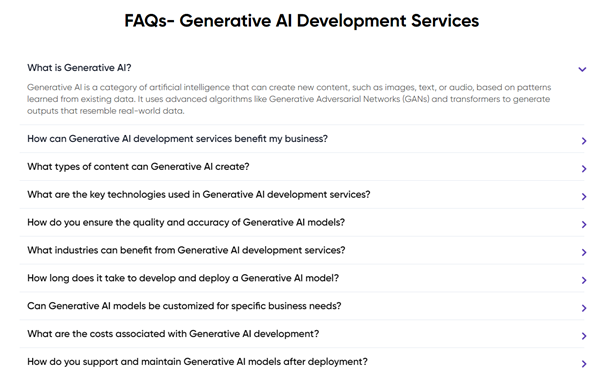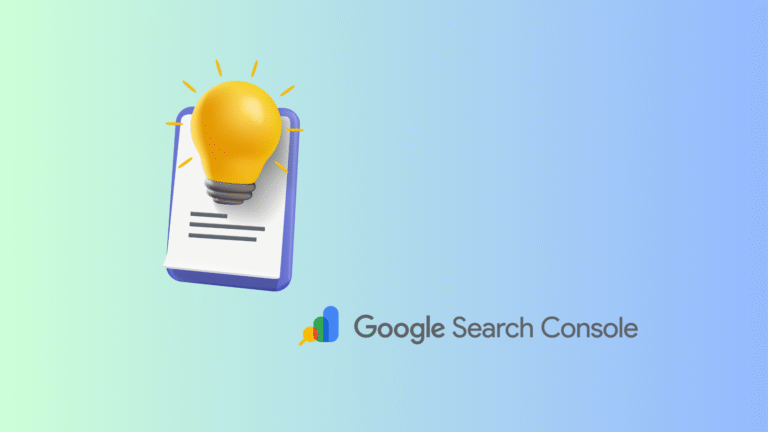Remember when ranking on Page 1 felt like the ultimate SEO win?
Well, in 2025 — Page 1 isn’t enough.
Search engines have evolved beyond simple lists of links. Today, Google, Bing, and even AI search tools like Perplexity and ChatGPT are shifting toward direct answers — pulled instantly from your content.
Today, over 58% of search results feature a snippet or PAA card. Google and AI models like ChatGPT, Perplexity, Bing Copilot, and Claude are all scanning the web — not just for keywords, but for structured, scannable, semantic content they can cite and summarize. If your blog doesn’t look like a snippet, it probably won’t become one.
This is where blog formatting becomes a skill set. Think like a search engine: Can it parse your heading hierarchy? Does your paragraph answer a question in 40–60 words? Is your HTML table clean and indexable? Are you using FAQ schema, max-snippet tags, or AI-friendly markdown?
This blog isn’t another high-level “write good content” checklist. It’s a technical, tactical guide to formatting your blogs for maximum visibility — not just in traditional Google results, but in AI-first interfaces. Whether you’re targeting the featured snippet, aiming to win PAA visibility, or hoping to be cited in AI Overviews and Generative Engine Optimization (GEO) results, the way you structure your content is what sets you apart.
Because in 2025, ranking isn’t just about relevance — it’s about structure, clarity, and AI comprehension. And the blogs that get formatted right are the ones that get quoted, cited, and surfaced — again and again.
What Are Featured Snippets & PAA Boxes?
The days of just “ranking in the top 10” are gone. Now, the real win is being extracted and shown as the answer — without users needing to click. That’s where Featured Snippets and People Also Ask (PAA) come into play.
Featured Snippets: Google’s Position Zero
A Featured Snippet is a special content block that appears above all organic search results, often called Position Zero. It’s designed to answer the searcher’s question instantly.
Here’s the catch:
You can’t apply for it. You earn it — by formatting your content strategically.
Google’s algorithm pulls content that:
- Directly answers the query
- Follows a scannable structure (headings, lists, tables)
- Matches the user’s search intent
Types of Featured Snippets
To optimize effectively, you need to match your formatting to the type of snippet Google is showing:
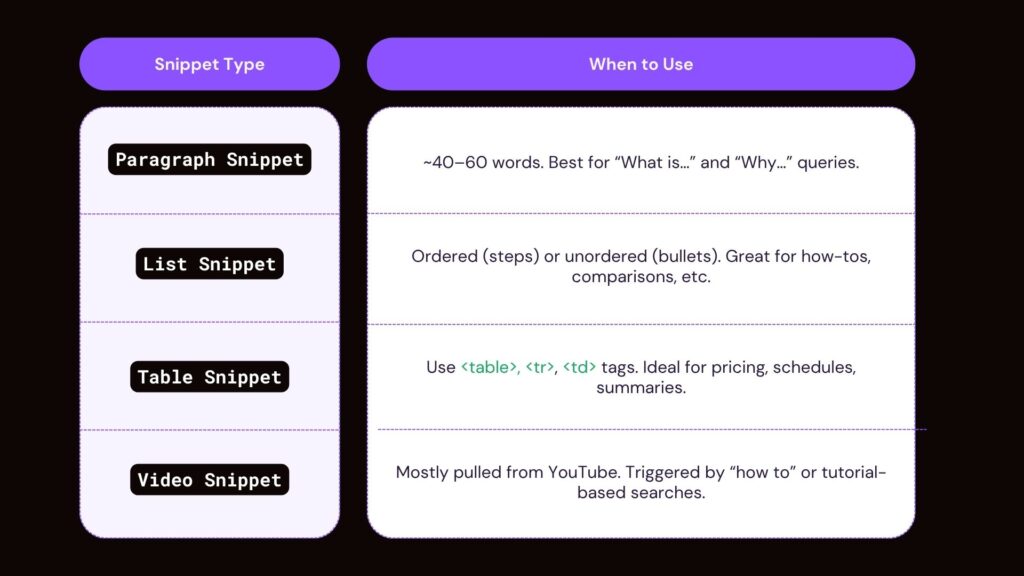
Example:
Search for “how to create a Content,” and you’ll often see a list-style snippet or video.

People Also Ask (PAA): A Hidden Goldmine
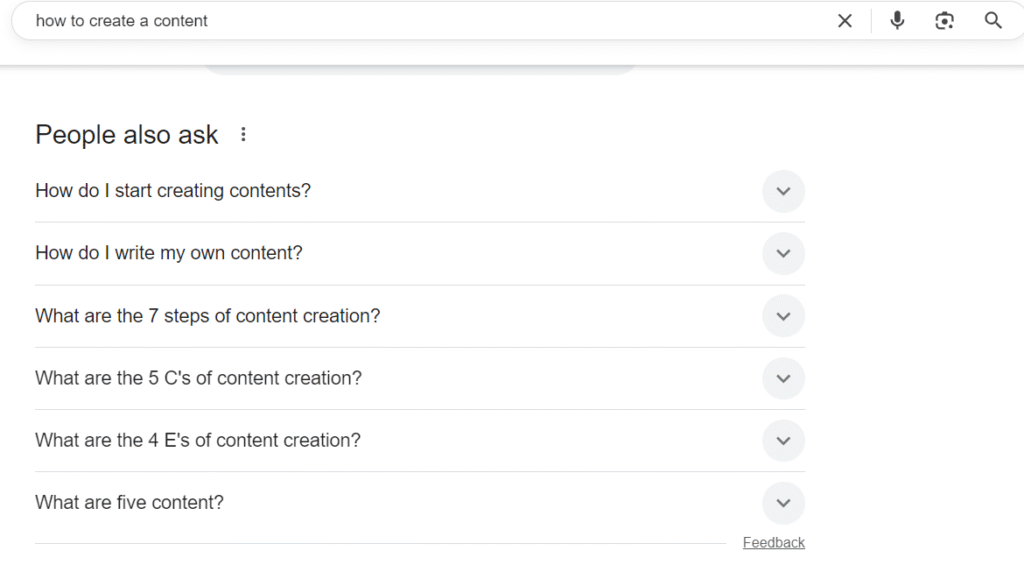
Right below the snippet (or sometimes even without one), you’ll find a box titled “People Also Ask.”
These are auto-generated follow-up questions based on the original query.
Why they matter:
- Each PAA box expands into a snippet-style answer
- One page can appear multiple times (main snippet + multiple PAAs)
- It gives you insight into related queries that Google connects to your main topic.
If you’re creating an FAQ section or answering related queries in subheadings, PAA is your low-hanging opportunity to dominate more SERP real estate.
Snippets and PAA are no longer optional—they’re core to visibility in AI-driven, zero-click search.
Identifying Snippet Opportunities (Keyword + SERP Analysis)
Before you format your blog to win Position Zero, you need to know which keywords even show snippets — and what kind. This is where data meets intuition. Use tools, analyze SERPs, and track patterns to reverse-engineer exactly what Google rewards.
Step 1: Use the Right Tools for Discovery
Use SEO research tools that help you filter keywords by snippet presence and identify low-hanging opportunities:
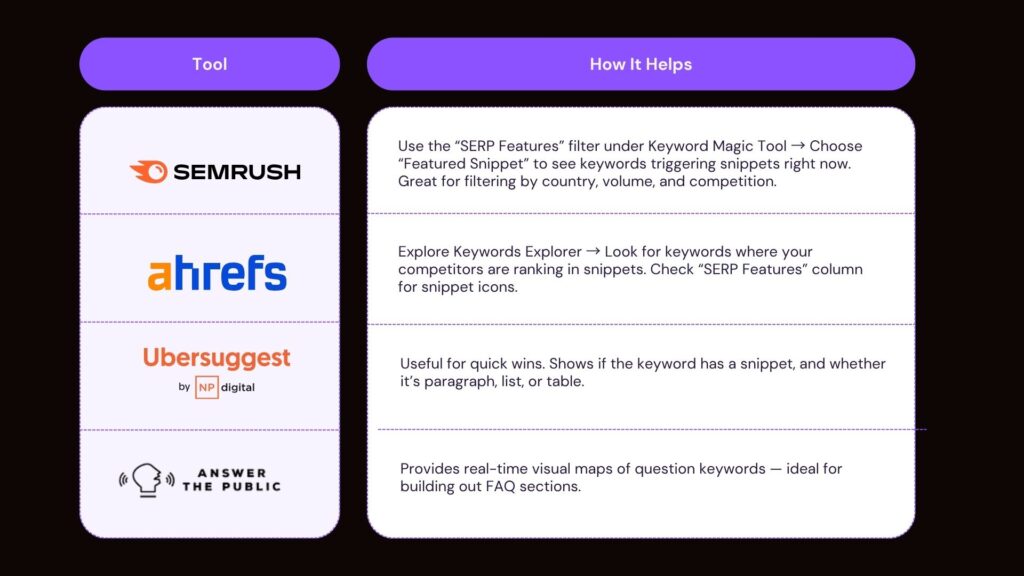
Export all snippet-trigger keywords and group them by intent and format; you’ll start seeing patterns (e.g., most “How to…” snippets are lists).
Step 2: Focus on Question-Based, Intent-Rich Keywords
Featured snippets mostly respond to informational and navigational queries. So prioritize:
- “How to…” → List snippets
- Example: “How to format a blog for snippet”
- “What is…” → Paragraph snippet
- Example: “What is a featured snippet”
- “Why does…” → Paragraph or definition
- “Steps to…” or “Tips for…” → List snippets
- “Pricing of…” or “Comparison between…” → Table snippets
Avoid vague or overly competitive keywords unless your domain has high authority.
Look for:
- Mid-volume, low-competition keywords
- Keywords that show snippets but where the current result is outdated or weak
Queries that show no snippet yet (opportunity to be first)
Step 3: Manually Analyze the SERP
Automated tools can only go so far. A manual SERP analysis helps you understand why Google chose a specific snippet.
Run this checklist:
- 🧐 Is there a snippet already?
If not, great — you might win it. If yes, analyze it. - 📦 What format is it?
Paragraph, List, Table, or Video — match your format to what Google is rewarding. - 📉 How strong is the snippet content?
If it’s a generic or outdated answer, you can beat it with more clarity, formatting, and structure.
Step 4: Analyze PAA Boxes and Google Autocomplete
These are treasure troves of untapped snippet queries.
- People Also Ask (PAA)
Open the box → Expand 3–4 follow-up questions → Note down:- What types of answers are shown?
- Are they short paragraphs or lists?
- Can your blog answer these in 50–75 words with clearer structure?
- What types of answers are shown?
- Autocomplete
Type part of your target keyword in Google and see what it suggests.
Example:
“How to format a blog…” → gets:- “How to format a blog for SEO”
- “How to format a blog post in WordPress”
- “How to structure a blog for Google snippet”
- “How to format a blog for SEO”
- These are your section headings or FAQ prompts.
Add these as H2 questions with concise answers underneath.
Wrap in <h2>, <p>, and optionally apply FAQ schema.
Step 5: Prioritize High-Intent & Actionable Queries
Not every question deserves snippet optimization. Focus on:
- Intent-driven queries (how to, best ways to, tips, tools)
- Direct informational asks (definitions, comparisons, steps)
- Zero-click likely keywords (where the answer appears without needing a click)
Don’t waste time optimizing snippets for purely commercial keywords. They rarely trigger snippets and tend to go straight to product ads or listings.
Once you’ve nailed the opportunities, you’re ready to go deeper.
How to Format Your Blog for Snippets (With Examples)
Formatting is the make-or-break for winning snippets. You might have the right keyword, but if the structure is messy or buried in fluff, Google skips it.
Here’s exactly how to format content for each type of featured snippet, with live-ready HTML examples and tactical guidelines.
1. Paragraph Snippets (Most Common)
Used for: What is, definition-style, and short answer queries
Structure:
- Use a clear H2 with the question.
- Immediately follow with a concise, objective answer (40–60 words).
- Avoid filler. Start with the answer, then add context.
Example:-
<h2>What is a featured snippet?</h2>
<p>A featured snippet is a selected search result that appears above all organic listings in Google, offering a concise answer to a user’s query. It can be a paragraph, list, table, or video, and is pulled algorithmically from top-ranking content.</p>
Tip: Think like a dictionary or Wikipedia. No opinions. Just facts. Google loves clarity.
2. List Snippets (How-To, Step-Based)
Used for: How to…, steps to…, best ways to…
Structure:
- Start with an H2 like: “How to Format a Blog for Snippet”
- Use H3s for steps or <ol> for ordered instructions
- Be consistent: start each step with a verb
Example (H2/H3 format):
- <h2>How to Format a Blog for Snippet</h2>
- <h3>Step 1: Choose a snippet-eligible keyword</h3>
- <h3>Step 2: Analyze current SERP snippet formats</h3>
- <h3>Step 3: Structure your content to match</h3>
Example (HTML list):
<h2>Steps to Add FAQ Schema</h2>
<ol>
<li>Write a question and answer section in your content</li>
<li>Generate FAQ schema using a trusted tool</li>
<li>Insert the JSON-LD schema in your blog's HTML</li>
<li>Validate the code using Google’s Rich Results Test</li>
</ol>
Keep each step/action under 25 words. Long blocks can significantly reduce your chances of being selected.
3. Table Snippets (Comparisons, Features, Pricing)
Used for: Comparisons, pricing tables, feature breakdowns
✅ Structure:
- Use semantic tags: <table>, <thead>, <tr>, <th>, <td>
- Keep it lean: Max 3–4 columns, 6–8 rows
- Use bold and clear headers for better parsing
✅ Example:
<h2>Comparison of Blog Formatting Techniques</h2>
<table>
<thead>
<tr>
<th>Format Type</th>
<th>Best For</th>
<th>Tips</th>
</tr>
</thead>
<tbody>
<tr>
<td>Paragraph</td>
<td>Definitions</td>
<td>Keep it under 60 words</td>
</tr>
<tr>
<td>List</td>
<td>How-to steps</td>
<td>Use consistent H3 tags or ordered lists</td>
</tr>
<tr>
<td>Table</td>
<td>Comparisons</td>
<td>Use <code><table></code> tags for clarity</td>
</tr>
</tbody>
</table>
Bonus: Add a sentence like “See the table below for a breakdown…” above it — Google sometimes grabs both paragraph + table.
4. Pro Snippet Tip: Add a Summary Sentence
After each key answer, include a summary-style sentence that reinforces the query + keyword. It improves AI/voice snippet eligibility too.
✅ Example:
“In short, the best way to format a blog for snippets is to use question-based headings, concise answers, and apply the right schema markup.”
This one line can often be the line Google lifts for AI Overviews or PAA inclusion.
Creating an SEO-Friendly FAQ Section (PAA + Voice Search Ready)
If there’s one underused goldmine in SEO right now, it’s the FAQ section.
It helps you:
- Capture People Also Ask (PAA) queries
- Rank for voice searches
- Boost visibility for long-tail keywords
- Get picked for AI snippets like ChatGPT and Google’s AI Overviews
But it’s not about dumping random questions at the end. The format matters as much as the content.
How to Structure FAQs for Snippet Extraction
Here’s the recommended formatting:
- Use H3 or H4 for each questions
- Follow with a concise 2–3 sentence answer
- Lead with the answer — no fluff or intros
Keep it factual and conversational (especially for voice search)
Example (Live-Ready HTML Format)
<h3>How long should a blog post be for SEO?</h3>
<p>The ideal blog length in 2025 is between 1,800–2,400 words, depending on topic and user intent. Long-form content performs best when structured clearly and supported with schema markup.</p>
<h3>What is the best way to structure a blog for snippets?</h3>
<p>Use H2s with questions, followed by 40–60 word answers. Format how-to steps as ordered lists, and use tables for structured data like comparisons or pricing.</p>
Best Practices to Keep in Mind
- 4–6 FAQs per blog is a good benchmark
- Prioritize question-based, long-tail keywords from PAA boxes, Google autocomplete, or tools like AnswerThePublic
- Avoid marketing jargon. Write in a tone you’d speak in. Voice assistants prefer natural phrasing.
Add FAQ schema (we’ll cover it in the next section) — this helps search engines understand your answers and show them in PAA and snippets.
Tip: Think Like a User, Not Just a Marketer
Users don’t always search “how to format a blog.”
They ask:
- “Do I need headings for Google snippets?”
- “Can I get a featured snippet with a list?”
- “How short should an SEO paragraph be?”
Adding these to your FAQ builds topical depth + SERP visibility — with just a few extra lines.
Technical Enhancements: Schema, Tags & Site Structure
Formatting a blog for snippets isn’t just about copy — it’s also about how your content is structured behind the scenes.
Here’s where technical SEO takes the front seat.
Add Schema Markup (Structured Data)
Schema helps Google (and AI models) understand the intent and format of your content.
Recommended types:
- FAQPage — For your FAQ section
- HowTo — For step-based tutorials or guides
- Article — For every blog post
Speakable — For voice search readiness (especially in How-To and News content)
Example JSON-LD for FAQ:
{
"@context": "https://schema.org",
"@type": "FAQPage",
"mainEntity": [
{
"@type": "Question",
"name": "How long should a blog post be for SEO?",
"acceptedAnswer": {
"@type": "Answer",
"text": "The ideal blog length in 2025 is between 1,800–2,400 words, depending on topic and user intent."
}
}
]
}
Add using plugins (like Rank Math, Yoast, or Schema Pro), or manually in your HTML for full control.
Meta Tags: Snippet Controls
Google gives you some levers to limit or exclude snippets if needed.
- max-snippet:[number] — limits how many characters Google can use in a snippet
- data-nosnippet — hides specific content blocks from snippet extraction (great for sensitive info)
Example:
<meta name="robots" content="max-snippet:155">
Use with caution; being too restrictive might cause you to miss snippet eligibility.
HTML & Site Structure
Google loves clean, semantic HTML.
Here’s what to use for better crawlability and snippet extraction:
- <main>, <article>, <section> for content grouping
- Hierarchical heading tags:
- One <h1>
- Multiple <h2>s for sections
- <h3>s for sub-points like FAQ or list steps
- One <h1>
- Avoid div soup, clarity matters
Mobile Optimization & Core Web Vitals
Even the best-formatted content won’t rank if your page performs poorly.
- Mobile-first design — your layout must work seamlessly on small screens
- LCP (Largest Contentful Paint): under 2.5s
- CLS (Cumulative Layout Shift): keep below 0.1
Tools:
- PageSpeed Insights
- Web.dev
- Chrome Lighthouse
Pro Tip: Structure Helps AI Too
Generative engines like ChatGPT, SGE, and Perplexity rely on cleanly structured content.
Using semantic tags, schema markup, and snippet controls boosts your machine readability — and your odds of being quoted by an AI assistant.
Align with Google’s Helpful Content & E‑E‑A‑T Signals
Google isn’t just scanning for keywords — it’s evaluating who is writing, why the content exists, and how helpful it really is.
And now with AI Overviews and generative search models (like ChatGPT and Perplexity), experience, authority, and clarity have become the new SEO superpowers.
People-First Content Still Wins
Forget keyword stuffing. The priority in 2025 is:
- Answer the query upfront
- Structure the blog around reader intent
- Avoid sales-y intros or generic filler
Example: If someone asks “how to write a schema for FAQ,” your first two lines should solve that — not pitch your tool or blog.
Add Author Bios & Expertise Tags
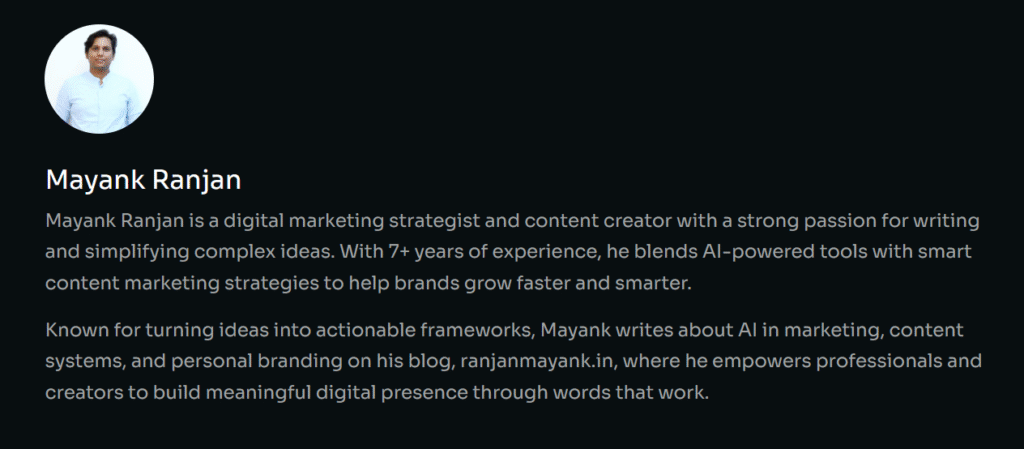
Establish your credibility:
- Add a short author bio with credentials (e.g., “Mayank Ranjan – 7+ years in SEO & AI-driven content marketing”)
- Use author, publisher, and datePublished schema for metadata
This not only aligns with E-E-A-T (Experience, Expertise, Authoritativeness, Trust), but it’s also crucial for AI models choosing citation-worthy content.
Cite Reputable Sources
If you’re quoting a stat or referencing a concept, link to the source.
- Prefer .edu, .gov, or known industry sites (Google, HubSpot, Statista, SEMrush)
- Avoid linking to low-EAT blogs or regurgitated content.
Example:
“According to Semrush’s 2025 Featured Snippet Report, paragraph snippets still dominate at 60%+ share.”
Use Expert Quotes, Real Data, or First-Hand Experience
Content that feels “written by someone who’s done the thing” gets favored both by Google and AI systems.
Try to include:
- Brief case studies
- Results from your own work
- Client outcomes (if available)
- Quotes from real professionals
Even if anecdotal, this adds depth and uniqueness AI models recognize.
Why It Matters for Snippets + AI Visibility
Google’s helpful content system scores content based on usefulness, not keyword density.
Generative engines like SGE, Perplexity, and ChatGPT cite content that’s credible, human, and well-structured.
This section is your chance to stand out through substance — not just formatting.
Formatting a blog for AI Overviews, Voice Search & GEO (2025 Trends)
Search is evolving fast — and if you’re not formatting for AI Overviews, voice search, and generative engine optimization (GEO), you’re already behind.
AI Overviews (like Google’s SGE) don’t just pull from one source — they assemble answers from multiple sites.
Voice assistants prefer short, spoken-friendly phrasing.
Generative engines like ChatGPT and Perplexity cite content that’s clean, structured, and semantically rich.
Let’s break down how to win in this new SERP battlefield:
AI Overviews: Format for Summarization
Your content must be AI-readable and summarization-friendly.
Here’s how:
- Start with a concise intro paragraph
Ideally 40–50 words that directly answer the query
Treat it like a TL;DR for the full post
- Use bullet lists wherever possible
Break down steps, features, pros/cons
Helps LLMs chunk your info clearly
- Add summary cues like:
“In summary, the best way to optimize your blog for snippets is to…”
- Use HTML structure correctly — <h2>, <h3>, <ul>, <p>
GEO: Generative Engine Optimization in Practice
GEO is all about being the source AI tools love to cite.
Here’s how to optimize for it:
🔹 Use H2/H3 anchors for each major topic
Makes content scannable and modular for LLMs
🔹 Include real stats with source mentions
“According to SEMrush, paragraph snippets account for 68% of all featured snippet results.”
🔹 Update your stats regularly
Outdated info = no citations.
Fresh data improves your inclusion in AI Overviews by up to 40%, per recent Cension.ai analysis.
🔹 Write with an expert POV
Add your own insight or results — not just reworded tips from top-ranking blogs.
Voice Search Optimization
Google Assistant, Siri, and Alexa are reading your content aloud. So format it that way.
- Use conversational phrasing
→ Imagine you’re explaining it to a beginner in 30 seconds - Place answers within the first 30–50 words
→ Voice snippets get cut off quickly - Implement Speakable schema markup
→ Helps machines understand which parts of your content are suitable for audio output
Pro Tip: Don’t just chase keywords, structure your insights for LLMs, voice assistants, and AI engines.
Your content isn’t just read anymore, it’s summarized, spoken, and selected.
Don’t Chase Rankings — Win Snippets
n today’s SERP landscape, it’s not always the best-written content that wins — it’s the best-formatted.
- Clarity beats cleverness.
Forget complex intros or bloated paragraphs. Snippets reward structure, not fluff. - Structure = Visibility.
Whether it’s a 40-word paragraph, a 5-step list, or a simple comparison table — formatting is what gets pulled, summarized, and cited. - AI search is expanding.
Google’s AI Overviews, voice assistants, and tools like ChatGPT are reshaping search behaviour. Formatting for both humans and machines is your moat.
“Snippets don’t require the best content, they require the best format.”
Start optimizing not just for clicks, but for citations, voice answers, and AI summarization.
Take Action Today
If you’re serious about content authority in the AI era:
- Publish your llms.txt and llms-full.txt — even if you start small
- Track citations using Perplexity, ChatGPT browsing, and Bing Copilot
- Iterate weekly or monthly as you publish new blogs.
- Share your implementation publicly — build credibility as an early adopter
The earlier you act, the more trust you build with AI tools, while others are still figuring it out.
You don’t just chase rankings anymore.
You build context that AI understands, references, and shares automatically.

Mayank Ranjan
Mayank Ranjan is a digital marketing strategist and content creator with a strong passion for writing and simplifying complex ideas. With 7+ years of experience, he blends AI-powered tools with smart content marketing strategies to help brands grow faster and smarter.
Known for turning ideas into actionable frameworks, Mayank writes about AI in marketing, content systems, and personal branding on his blog, ranjanmayank.in, where he empowers professionals and creators to build meaningful digital presence through words that work.


